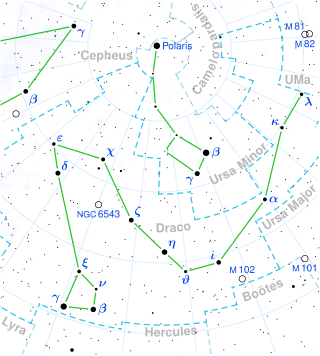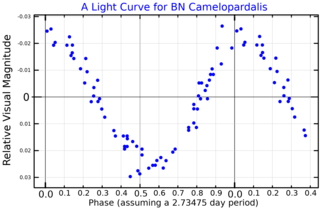
Sigma Draconis is a single star in the northern constellation of Draco. It has the proper name Alsafi, while Sigma Draconis, which is latinised from σ Draconis and abbreviated Sig Dra or σ Dra, is the Bayer designation. It has an apparent visual magnitude of 4.7, which is bright enough to be faintly visible to the naked eye. Based on parallax measurements, this star is located at a distance of 18.8 light years from the Sun. It is receding from the Sun with a radial velocity of 26.6 km/s.
Pi1 Ursae Minoris is a common proper motion binary star system in the northern circumpolar constellation of Ursa Minor. The pair have apparent visual magnitudes of +6.58 and +7.31, with a combined magnitude of 6.1. They are located about 71 light years from the Sun. The two have an angular separation of 31.4 arc seconds, which corresponds to a physical separation of about 680 AU, and orbit each other with a period of about 13,100 years.

Lambda Draconis, also named Giausar, is a solitary, orange-red star in the northern circumpolar constellation of Draco. It is visible to the naked eye with an apparent visual magnitude of +3.85. Based upon an annual parallax shift of 9.79 mas as seen from the Earth, the star is located around 333 light years from the Sun.

Kappa Draconis, Latinized from κ Draconis, is a blue giant star located in the northern circumpolar constellation of Draco. At an apparent magnitude of 3.88, it is barely visible to the naked eye when artificial lighting from cities is present. Nevertheless, it is a powerful star, approximately five time as massive as the Sun. It is about 460 light-years away, and is 1,400 times brighter than the Sun.

Alpha Camelopardalis, Latinized from α Camelopardalis, is a star in the northern constellation of Camelopardalis. With an apparent visual magnitude of 4.3, it is the third-brightest star in this not-very-prominent circumpolar constellation; the first and second-brightest stars being Beta Camelopardalis and CS Camelopardalis, respectively. It is the farthest constellational star, with a distance of approximately 6,000 light-years from Earth based on parallax measurements.

CS Camelopardalis is a binary star in reflection nebula VdB 14, in the constellation Camelopardalis.
43 Camelopardalis is a single star in the northern circumpolar constellation of Camelopardalis, located roughly 1,060 light years away from the Sun based on parallax. It is visible to the naked eye as a faint, blue-white hued star with an apparent visual magnitude of 5.11. This object is moving closer to the Earth with a heliocentric radial velocity of −21 km/s.
42 Camelopardalis is a single star in the constellation Camelopardalis, located roughly 770 light years away from the Sun. It is visible to the naked eye as a faint, blue-white hued star with an apparent visual magnitude of 5.14. The visual magnitude of the star is diminished by an extinction of 0.22 due to interstellar dust. It is moving further from the Earth with a heliocentric radial velocity of 3 km/s. 42 Camelopardalis has a peculiar velocity of 24.4+1.9
−2.1 km/s and may be a runaway star.
3 Centauri is a triple star system in the southern constellation of Centaurus, located approximately 300 light years from the Sun. It is visible to the naked eye as a faint, blue-white hued star with a combined apparent visual magnitude of 4.32. As of 2017, the two visible components had an angular separation of 7.851″ along a position angle of 106°. The system has the Bayer designation k Centauri; 3 Centauri is the Flamsteed designation. It is a suspected eclipsing binary with a variable star designation V983 Centauri.
4 Camelopardalis is a probable multiple star in the northern constellation of Camelopardalis, located 177 light years away from the Sun, based upon parallax. With a combined apparent visual magnitude of 5.29, it is visible to the naked eye as a faint, white-hued star. The pair have a relatively high proper motion, traversing the celestial sphere at an angular rate of 0.158″ per year. The system's proper motion makes it a candidate for membership in the IC 2391 supercluster. They are moving away from the Earth with a heliocentric radial velocity of 22.5 km/s.

HD 27245, also known as HR 1335 or rarely 25 H. Camelopardalis is a solitary red-hued star located in the northern circumpolar constellation Camelopardalis. It has an apparent magnitude of 5.4, making it faintly visible to the naked eye. Gaia DR3 Parallax measurements place it approximately 607 light years away from it the Solar System and is drifting further away with a heliocentric radial velocity of 25.2 km/s. At its current distance, HD 27245's brightness is diminished by 0.36 magnitudes due to extinction from interstellar dust. It has an absolute magnitude of −0.27.

BN Camelopardalis is a suspected astrometric binary in the northern circumpolar constellation of Camelopardalis. It appears as a variable star that is visible to the naked eye as a dim, white-hued point of light with an apparent visual magnitude that fluctuates around 5.49. The system is located at a distance of around 310 light years from the Sun based on parallax, and is drifting further away with a radial velocity of +9 km/s.
HD 30442 is a solitary star in the northern circumpolar constellation Camelopardalis. It is faintly visible to the naked eye with an apparent magnitude of 5.47 and is estimated to be 403 light years away from the Solar System. The object has a heliocentric radial velocity of −37 km/s, indicating that it is drifting closer.
HD 139357 is a 6th magnitude K-type giant star located approximately 370 light years from Earth, visible in the constellation Draco. Its mass is four thirds that of the Sun but its radius is 11.47 times larger. However, despite being a giant star, it is only 3.07 billion years old, which is younger than the Sun.

Theta Draconis, a name Latinized from θ Draconis, is a binary star system in the northern circumpolar constellation of Draco. It is faintly visible to the naked eye at night with an apparent visual magnitude of 4.12. Parallax measurements place it at an estimated distance of 68.6 light-years from the Sun, and it is drifting closer with a radial velocity of −8 km/s. It has a relatively high proper motion, traversing the celestial sphere at the rate of 0.464″ per year. O. J. Eggen included this star as a member of the NGC 1901 supercluster based on its space motion.
68 Draconis is the Flamsteed designation for a star in the northern circumpolar constellation of Draco. It has an apparent visual magnitude of 5.69, so, according to the Bortle scale, it is faintly visible to the naked eye from suburban skies at night. Measurements made with the Gaia spacecraft show an annual parallax shift of 0.0209232″, which is equivalent to a distance of around 156 ly (48 pc) from the Sun. It is moving closer to the Earth with a heliocentric radial velocity of –14.6 km/s. The star has a relatively high proper motion, traversing the celestial sphere at a rate of 0.150″ per year.

9 Ceti is a star in the equatorial constellation of Cetus. It has the variable star designation BE Ceti, while 9 Ceti is the Flamsteed designation. It has an apparent visual magnitude of 6.4, which is below the limit that can be seen with the naked eye by a typical observer. Based upon parallax measurements, this star is 69.6 light years away from the Sun.

HD 27022, also known as HR 1327, is a star located in the northern circumpolar constellation Camelopardalis. The object has also been designated as 20 H. Camelopardalis, but is not commonly used in modern times. It has an apparent magnitude of 5.27, allowing it to be faintly visible to the naked eye. Based on parallax measurements from Gaia DR3, the star has been estimated to be 347 light years away. It appears to be approaching the Solar System, having a heliocentric radial velocity of −19.5 km/s.
HD 37289, also known as HR 1916, is a solitary, orange hued star located in the northern circumpolar constellation Camelopardalis. It has an apparent magnitude of 5.61, making it faintly visible to the naked eye under ideal conditions. Based on parallax measurements from the Gaia spacecraft, the object is estimated to be 308 light years distant. It appears to be approaching the Sun, having a heliocentric radial velocity of −20.7 km/s.
EK Eridani is a single variable star in the equatorial constellation of Eridanus. It has the designation HR 1362 from the Bright Star Catalogue; EK Eridani is the variable star designation, abbreviated EK Eri. This star is dimly visible to the naked eye with a brightness that fluctuates around 6.15. Based on parallax measurements, it is located at a distance of 209 light years from the Sun. The star is drifting further away with a heliocentric radial velocity of 6.9 km/s.







